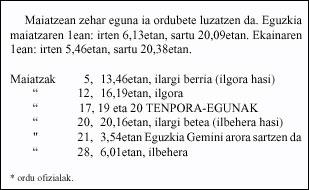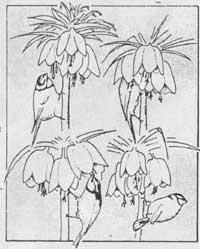Digital pollination of bees in Usurbil
2000/05/01 Avila Rodriguez, Gontzal | Avila Rodriguez, Iosune Iturria: Elhuyar aldizkaria
Those who collaborate with nature to make a living know perfectly the importance of protecting the environment, the consideration of being smaller. Although they would be giants among the smallest creatures, bees have a capital importance for nature and the human being. In fact, one in three foods taken by humans would be the result of a work done by a bee, butterfly, bird or other pollinator. Among the pollinating insects is the bee, which represents from 73% to 88% of the pollination.
Pollination is important!
The pollination consists of transporting the pollen that forms in the stamina of a flower -part of the flowers - to the pistil of the same or of another flower -female part of the flower. It is, therefore, a vital process for life, since pollination is the main cause of proliferation of plants.
To be able to transport the pollen from the plant to the plant is used more than one way in the richness of nature. Although the means of transport can be very varied, according to the type of pollination, the plants have been divided into three groups: hydrophilic plants, anemogenes and entomophiles. Since hydrophilic plants transport pollen through water, this type of pollination is not very important, since it refers exclusively to aquatic plants. Pollination is anomalous when the wind is the path chosen by pollen. Gymnosperm plants, with naked seeds and ovules that grow on scales, are of great importance in the case, for example in conifers, while in angiosperms, plants with eggs in a closed ovary, occurs with some, such as corn or chestnut. In the case of entomophilous pollination, transporters are usually insects. Insect pollination is very important in angiosperms, apple trees, pears or plum plants. While the insects are dedicated of flowers to take their food, nectar and pollen, without realizing it, they stick the pollen to the body and transport it without realizing another flower, thus ensuring the sexual reproduction of the plants.
Listorras, flies, beetles, butterflies... are skilled pollinators, but the most skilled is the bee. Bees pollinate more than 3/4 of the total planted plants that feed man and 90% of all plants with flowers of the world. It is estimated that in the absence of bees 3,000 species of plants would be lost. So something, right?
The ecosystem, however, is not only a matter of figures, but also of quality. When pollination is adequate, the fruits are healthier and larger, but when the size of the fruits is poor, they fall unripe and deformations occur. All this has a great influence on the production and life of the ecosystem. Roots, seeds, leaves, etc. From all plants enrich the soil and ensure food, protection ... and survival of many animals.
Therefore, if it is assumed that adequate pollination improves production, why not protect our production more? Why not protect the work and customs of always in our hamlets? Proof of the concern of the beekeepers for the topic is the project that the Gipuzkoa Beekeepers Association and the Genetics Department of the University of the Basque Country, in collaboration with the beekeepers associations of the Basque Country, have for the recovery and protection of the black bee here. It has nothing to do with it and may not be so important, but in Usurbil there are also doing nice work and research on bees.
Investigation of pollination coverage in Usurbil
One of the indicators of Usurbil, in addition to the walls and cider houses of his church, is the sensitivity of this people to beekeeping. If in Usurbil there is an association of beekeepers, the honey called Gorostitxo has been inaugurated, and in the last two years the Bee Day has been celebrated. The last Bee Day, on 29 April, in the field of pollination, has aimed to overcome the ignorance of the current society.
The research to be exposed below had similar objectives. On the one hand, know the non-pollinated surface of Usurbil and the types of plants of this surface, and on the other hand, indicate the most adequate location of the new hives that can be implanted in the future, following various criteria.
To achieve these objectives, with the help of a Usurbil beekeeper, an exact location of the first hives was carried out on a topographic map. The data extracted was introduced into the computer through the software AutoCad and Idrisi, defining the limits of the municipal term. This delimited the scope of the investigation. Later digital maps were made. Once the location of the hives was digitized, each of them was assigned a coverage area of one kilometer radius, although there is no significant consensus among the experts in this criterion. In the first map the limits and hives of the municipal term are detailed. This map gave an idea of relief, since it was a three-dimensional map. It is important to put orientation points in the works with maps. In the case of beekeeping, since the location of new hives is usually determined based on orientation, the explanation of these data was essential. In fact, knowledge of some weather data allowed measuring the suitability of the beehives location, mainly the main direction of the wind. Not only that, it could also be foreseen on what slope and where it would be appropriate to place the future beehives.
In addition to the orientation, the possibility of incline slope could be considered. Thus, from the topographic map in three dimensions, the slope map of slopes was made. With this map it was known the difficulty of reaching different places. Taking into account that it is relatively difficult to walk through areas of inclination greater than 25-30º, even more when you have to walk with load, as it happens in beekeeping, it was possible to know that due to the inclination of Usurbil there was little inadequate space for beekeeping.
You have to look at the vegetation
After analyzing the variations of the slope of the slopes, the next step was to observe the vegetation. For this purpose, a map of plants was developed from maps currently in digital format. These digital maps are made up of numerous plant species, so they had to adapt to the plants of the area of Usurbil. All this to know the plant species existing in Usurbil and its distribution. All plants were included in 10 groups.
They overlaid the map of the pollination zone covered by the hives and the map of plants. For this purpose, maps were made in two and three dimensions. The superposition of maps allowed to determine pollinated and non-pollinated surfaces. Thanks to this map it was observed that most of the surface of Usurbil was covered by bees. From there, it could already be quite clear which type of plants had on the non-pollinated surface, and which could be the most suitable places to place beehives according to these plants. Taking into account the orientation of the map, and knowing that winds and storms arrive mostly from the northwest, it was observed that the most appropriate is to place the new hives to the southeast. Thus, on the one hand, the beehives would be oriented to the south and on the other, they would have the protection of the mountain.
The last map was also produced. On this map one could see on the one hand the surface covered by the hive, but on the other hand the interference of the area of coverage of each hive with the areas of coverage of the adjacent hives. With this, in addition to knowing something about the intensity of local pollination, the competition between beehives was visible.
Result of the work
Once the maps were made and the study was done, it is time to collect the harvest to know the result of the work done and draw conclusions. Four main ideas stand out:
1) Approximately 90% of the land in Usurbil is affected by beehives, so they are pollinated.
2) In the central areas of the municipal term there is a strong competition and intensity between beehives, while as they approach the limits of the municipal term competition decreases considerably and the pollination intensity is much lower.
3) From the point of view of all the pollination of Usurbil, if in the future beehives are implanted, two zones must be taken into account: the first to the north, on the slopes of mount Mendizorrotz, and the second to the south, on the slopes of mount Isasti. Next to these two main areas, on the West border of Usurbil, there are a number of small spaces to consider.
4) From the point of view of plant type and orientation, the most suitable place for the implementation of new hives is the north. Its vegetation, besides being formed by shrubs, meadows and grasslands, presents a south orientation. The southern area, on the slopes of Mount Isasti, being the majority of coniferous plants, does not seem to be an ideal place for the location of hives.
The research has been carried out in Usurbil, but from the methodological point of view there is no doubt that it can be carried out in any municipality of Euskal Herria. The desire to start beekeeping can help those who do not have a clear criterion. The appropriate pollination processes are necessary for nature and the human being in order to be healthy. In it you can help nature. Therefore, break the limits and spread the pollination!

Gai honi buruzko eduki gehiago
Elhuyarrek garatutako teknologia




